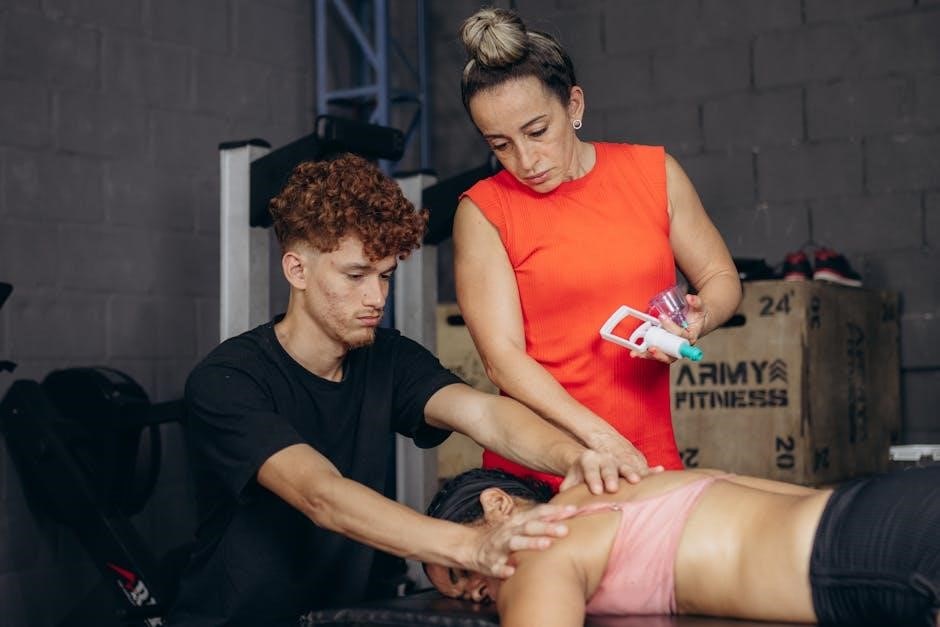
manual handling train the trainer
Manual handling training is crucial for reducing workplace injuries. This “Train the Trainer” program equips instructors with the skills to teach safe handling practices, promoting a safety-first culture.
1.1 Definition of Manual Handling
Manual handling involves lifting, carrying, or moving loads by hand or bodily force, such as lifting, carrying, lowering, or pushing objects. It is the most common cause of workplace injuries, impacting both work and personal life. Proper training is essential to minimize risks and ensure safe practices. This subheading focuses solely on defining manual handling without addressing related topics like training methods or regulations.
1.2 Importance of Manual Handling Training
Manual handling training is essential for reducing workplace injuries and promoting a safe working environment. It equips employees with the knowledge and skills to perform tasks safely, minimizing the risk of injury. Proper training helps identify hazardous tasks, conduct risk assessments, and implement safe handling practices. This not only protects employees but also reduces organizational costs related to injuries and absenteeism. Effective training fosters a culture of safety, ensuring compliance with legal standards and improving overall workplace productivity and well-being.
1.3 Overview of the Train the Trainer Program
The “Train the Trainer” program equips individuals with the skills to deliver effective manual handling training. It focuses on risk reduction, safe lifting practices, and legal compliance. Participants learn to identify hazards, conduct assessments, and implement safe handling techniques. The program emphasizes practical training methods, including real-life scenarios and simulations, to ensure trainers can effectively teach others. By fostering a safety-first approach, the program aims to reduce workplace injuries and promote a culture of safe manual handling practices across organizations.

The Role of the Trainer in Manual Handling
The trainer empowers participants with knowledge and skills to handle manual tasks safely, fostering a culture of safety and ensuring compliance with regulations.
2.1 Responsibilities of a Manual Handling Trainer
A manual handling trainer is responsible for planning and delivering effective training sessions, demonstrating safe techniques, and providing feedback to participants. They must ensure compliance with legal standards and tailor content to meet specific workplace needs. Trainers also assess participant understanding, address misconceptions, and promote a culture of safety. Utilizing practical exercises and visual aids, they equip learners with the skills to minimize injury risks. Their role extends to monitoring progress and offering guidance for continuous improvement in manual handling practices.
2.2 Key Skills Required for Effective Training
Effective manual handling trainers need strong communication and interpersonal skills to engage participants. They must demonstrate practical techniques clearly and provide constructive feedback. Attention to detail is crucial to identify unsafe practices. Trainers should be patient, empathetic, and approachable to cater to diverse learning needs. Proficiency in adult learning principles and the ability to create an interactive environment are essential. Knowledge of legal standards and the capacity to adapt training to workplace-specific risks further enhance their effectiveness in promoting safe manual handling practices.
2.3 Legal and Regulatory Requirements for Trainers
Trainers must comply with legal and regulatory standards, such as ISO 9001 and OSHA guidelines, ensuring training aligns with national and industry-specific laws. They must stay updated on workplace safety legislation and incorporate it into their programs. Trainers are responsible for ensuring all training materials meet regulatory requirements, fostering compliance and reducing organizational liability. Adherence to these standards is critical for promoting a safe working environment and minimizing the risk of manual handling injuries.

Core Concepts of Manual Handling
Manual handling involves safely moving or supporting loads, focusing on ergonomics, posture, and balanced techniques to minimize injury risks and ensure efficient task completion.
3.1 Understanding Manual Handling Risks
Manual handling risks arise from tasks that involve lifting, lowering, pushing, pulling, or carrying loads, which can strain muscles and lead to injuries. These risks are often linked to poor posture, inadequate techniques, or excessive workload. Identifying such risks is crucial to prevent workplace injuries and ensure a safe environment. Trainers must emphasize the importance of assessing tasks for potential hazards and teaching strategies to mitigate them effectively. Understanding these risks is the foundation of safe manual handling practices.
3.2 Principles of Safe Lifting and Handling
The principles of safe lifting and handling emphasize maintaining a neutral spine, bending at the knees, and using leg muscles instead of the back. Planning the lift, keeping the load close to the body, and avoiding twisting are key. Assessing the load’s size, weight, and balance is essential. Trainers should teach participants to use appropriate equipment and techniques, ensuring the task is within their physical capabilities. Proper posture and controlled movements minimize injury risks and promote efficiency.
3.3 The Science Behind Manual Handling Injuries
Manual handling injuries often result from repetitive strain, poor posture, or improper lifting techniques. The musculoskeletal system, particularly muscles, tendons, and ligaments, bears the brunt of these stresses. Prolonged or excessive force can lead to micro-tears, inflammation, and pain. Spinal biomechanics play a critical role, as heavy loads and awkward postures increase the risk of disc herniation or nerve compression. Understanding these physiological responses is crucial for trainers to emphasize injury prevention strategies and promote safe practices.
3.4 Legal Standards and Guidelines
Legal standards and guidelines for manual handling are established to protect workers from injuries. Regulations such as the Manual Handling Operations Regulations 1992 require employers to assess and reduce risks. Trainers must ensure compliance by teaching safe practices and conducting risk assessments. These guidelines emphasize proper lifting techniques, load limits, and ergonomic considerations. Adhering to these standards helps organizations avoid legal liabilities and promotes a safer working environment. Trainers play a key role in ensuring these regulations are understood and applied effectively.

Risk Assessment and Management
Risk assessment and management are critical to identifying and mitigating manual handling hazards, ensuring a safer workplace and legal compliance through effective strategies and controls.
4.1 Identifying Hazardous Manual Handling Tasks
Identifying hazardous manual handling tasks involves evaluating tasks that pose risks of injury due to factors like heavy loads, awkward postures, or repetitive movements. Trainers should observe workplace practices, analyze incident reports, and consult with workers to pinpoint high-risk activities. Tasks requiring excessive force, prolonged periods of bending, or lifting from unsafe distances are often flagged. Understanding these factors helps in prioritizing tasks for assessment and implementing targeted safety measures to reduce injury risks and improve workplace safety standards.
4.2 Conducting a Manual Handling Risk Assessment
Conducting a manual handling risk assessment involves systematically evaluating tasks to identify potential risks of injury. Trainers should observe the task, consult with workers, and analyze data on injuries or near misses. Factors such as load weight, distance carried, and posture are assessed. The goal is to determine the level of risk and prioritize tasks for intervention. This process ensures a proactive approach to reducing injuries and improving workplace safety through data-driven decision-making and targeted solutions.
4.3 Developing a Risk Management Plan
Developing a risk management plan involves creating a structured approach to mitigate identified manual handling risks. This includes prioritizing tasks based on risk levels and implementing controls such as task redesign, equipment provision, or training. The plan should assign responsibilities, set timelines, and outline monitoring processes. Regular reviews ensure the plan remains effective, while feedback mechanisms allow for continuous improvement. A well-designed plan reduces injuries and fosters a safer work environment by addressing risks systematically.
4.4 Avoiding Unnecessary Manual Handling
Avoiding unnecessary manual handling is a key strategy in reducing risks. This involves assessing tasks to determine if manual handling is required or if alternatives, such as automation or mechanical aids, can be used. Trainers should emphasize task redesign, ergonomic adjustments, and the use of tools to minimize manual labor. Encouraging employees to question tasks that involve unnecessary lifting or moving can significantly reduce injury risks and improve workplace efficiency.

Training Methods and Techniques
Effective training methods include interactive workshops, simulations, and hands-on practice, ensuring comprehensive skill development and practical application for manual handling trainers.
5.1 Instructional Strategies for Manual Handling
Effective instructional strategies for manual handling training involve combining theoretical knowledge with practical application. Trainers should use adult learning principles, fostering an interactive and engaging environment. Demonstrating proper techniques, such as safe lifting postures and load handling, is crucial. Incorporating group activities and real-life scenarios enhances participation and understanding. Trainers should also encourage questions and discussions to address specific workplace challenges, ensuring learners can apply the training effectively in their roles.
- Focus on experiential learning through hands-on practice.
- Use visual aids to reinforce key concepts.
- Encourage active participation and feedback.
5.2 Balancing Theory and Practical Training
Balancing theory and practical training is essential for effective manual handling instruction. Theory provides foundational knowledge, such as risk factors and legal standards, while practical training reinforces learning through hands-on exercises. Trainers should structure sessions to blend both elements, ensuring participants understand concepts and can apply them safely. Practical demonstrations, simulations, and group activities help bridge the gap, making training relevant and applicable to real-world scenarios.
- Start with theoretical concepts to build awareness.
- Reinforce learning with practical, task-specific exercises.
- Ensure activities mirror real workplace situations.
5.3 Using Visual Aids and Demonstrations
Visual aids and demonstrations are powerful tools for enhancing manual handling training. They help participants visualize proper techniques and understand complex concepts; Videos, images, and diagrams can illustrate safe lifting methods, while live demonstrations provide practical examples. Trainers should use real-life scenarios to make learning interactive and engaging. This approach improves retention and ensures participants can apply skills effectively in their workplace.
- Use videos to show step-by-step techniques.
- Incorporate images and diagrams for clarity.
- Conduct live demonstrations for practical insight.
5.4 Incorporating Simulation and Hands-On Practice
Incorporating simulation and hands-on practice into manual handling training enhances skill development and real-world application. Simulations mimic workplace scenarios, allowing participants to practice tasks safely. Hands-on exercises help trainees master proper techniques, reducing the risk of errors; Trainers should provide immediate feedback to refine practices. This interactive approach ensures participants are confident and competent in applying manual handling skills effectively in their work environments.
- Use workplace-specific simulations for relevance.
- Encourage hands-on practice to reinforce learning.
- Provide feedback to improve technique.

Curriculum Design for Manual Handling Training
Curriculum design involves organizing training content to align with organizational goals and legal standards, ensuring a balance of theory, practical exercises, and real-life scenarios for effective learning.
6.1 Structuring the Training Program
Structuring the training program involves creating a logical flow of sessions, starting with foundational concepts and progressing to advanced techniques. Clear objectives and timelines ensure a balanced mix of theory and practical exercises. Trainers should allocate time for demonstrations, group activities, and individual practice to reinforce learning. The structure must adapt to different learner needs and roles, ensuring relevance and engagement. Regular breaks and assessments are included to monitor progress and ensure continuous improvement throughout the program.
6.2 Including Real-Life Scenarios and Case Studies
Incorporating real-life scenarios and case studies enhances the practical relevance of manual handling training. Trainees engage more effectively when they can relate to real-world examples, such as workplace accidents or common injuries. Case studies provide opportunities to analyze risks, discuss prevention strategies, and apply safe handling techniques. This approach bridges the gap between theory and practice, ensuring trainees are better prepared to handle real-world challenges in their work environments.
6.3 Emphasizing Ergonomics and Posture

Ergonomics and posture are critical components of manual handling training. Proper body alignment reduces the risk of injury and improves efficiency. Trainers should demonstrate how to maintain neutral spine positions and avoid twisting or bending. Practical exercises can help trainees understand optimal postures for various tasks. Emphasizing ergonomic principles ensures trainees adopt safe working practices, reducing long-term musculoskeletal risks and enhancing overall workplace safety.
6.4 Integrating Feedback and Assessment
Feedback and assessment are essential for ensuring trainees grasp manual handling techniques. Trainers should provide immediate, constructive feedback to correct improper methods. Practical assessments, such as hands-on tests, help verify understanding. Peer reviews and self-assessments also foster accountability. Regular evaluation ensures compliance with safety standards and identifies areas for improvement. Continuous feedback loops promote a culture of learning and refinement, ultimately enhancing the effectiveness of the training program.
Delivery of Manual Handling Training
Effective delivery involves creating an interactive environment, using practical demonstrations, and encouraging participation. Trainers should adapt their approach to suit different learning styles, ensuring engagement and understanding.
7.1 Engaging Participants in the Training Process
Engaging participants is crucial for effective learning. Trainers should create a supportive environment, encourage questions, and use interactive activities like group discussions and hands-on exercises.
Real-life scenarios and case studies help participants relate to the content. Active participation fosters better retention and application of manual handling techniques in real-world situations.
Trainers should also incorporate feedback sessions to address concerns and clarify doubts, ensuring participants feel involved and valued throughout the training process.
7.2 Ensuring Active Participation and Interaction
Active participation and interaction are vital for effective learning. Trainers should encourage questions, discussions, and hands-on activities to keep participants engaged.
Techniques like role-playing, group exercises, and problem-solving tasks can enhance interaction and practical understanding.
Trainers should also adapt their delivery style to suit different learning preferences, fostering a collaborative environment where everyone feels comfortable contributing.
This approach ensures participants are not passive learners but active contributors to their own development.
7.3 Providing Individualized Feedback
Providing individualized feedback is essential for helping participants improve their manual handling techniques.
Trainers should observe and assess each participant’s performance, offering timely and specific feedback.
This ensures participants understand their strengths and areas for improvement.
Feedback should be constructive, focusing on safe practices and proper ergonomics.
By tailoring feedback to individual needs, trainers can enhance learning outcomes and reduce injury risks.
This personalized approach also builds confidence and encourages continuous improvement.
7.4 Encouraging a Safety Culture

Encouraging a safety culture is crucial for sustaining manual handling best practices beyond training.
Trainers should promote a workplace environment where safety is prioritized and valued.
This involves fostering open communication, encouraging incident reporting, and recognizing safe behaviors.
Leadership commitment and employee participation are key to building a culture of safety.
Trainers should model safe practices themselves and emphasize the importance of accountability.
By fostering a proactive approach to safety, organizations can reduce injuries and improve overall well-being.

Monitoring and Evaluation
Monitoring and evaluation ensure the effectiveness of manual handling training.
Regular assessments and feedback help track progress and identify improvement areas.
Trainers must evaluate training outcomes to maintain compliance and enhance program quality.
8.1 Assessing Participant Understanding
Assessing participant understanding is crucial to ensure effective learning outcomes.
Trainers use quizzes, practical demonstrations, and group activities to evaluate knowledge retention.
Observing participants during hands-on exercises helps identify technique flaws and knowledge gaps.
Immediate feedback is provided to correct mistakes and reinforce proper manual handling techniques.
This step ensures participants can apply what they’ve learned, reducing the risk of workplace injuries.
8.2 Evaluating Training Effectiveness
Evaluating training effectiveness ensures that manual handling courses achieve their intended goals.
This involves monitoring injury rates, observing workplace practices, and gathering feedback.
Trainers assess whether participants apply safe handling techniques consistently.
Surveys, performance metrics, and workplace inspections are commonly used tools.
The findings help identify strengths and areas for improvement in the training program.
By measuring outcomes, trainers can refine their methods to enhance future training sessions.
8;3 Gathering Feedback for Continuous Improvement
Gathering feedback is crucial for refining manual handling training programs.
Trainers collect input from participants through surveys, questionnaires, or discussions.
This feedback highlights strengths and identifies areas needing improvement.
Specific, actionable insights help refine content and delivery methods.
Feedback also ensures the program remains relevant and effective over time.
By prioritizing participant perspectives, trainers foster a culture of continuous learning and adaptation.
8.4 Maintaining Trainer Competency
Maintaining trainer competency ensures high-quality manual handling instruction.
Trainers must stay updated on industry standards and best practices.
Regular professional development, such as workshops and certifications, is essential.
Practical experience and continuous learning reinforce their expertise.
Trainers should also seek feedback from participants to refine their skills.
By committing to ongoing development, trainers remain effective and credible.
This ensures the training program delivers consistent, impactful results.
Manual handling training is crucial for workplace safety and efficiency.
Trainers play a vital role in equipping participants with essential skills.
Continuous learning and practical application ensure long-term success.
Organizations should prioritize regular updates and consistent enforcement of safe practices.

9.1 Summarizing Key Takeaways
Manual handling train the trainer programs empower instructors with the knowledge to reduce workplace injuries and promote safe practices.
Key takeaways include understanding manual handling risks, mastering proper lifting techniques, and effectively communicating these principles to others.
Trainers should emphasize risk assessments, practical demonstrations, and fostering a culture of safety.
Continuous learning and adaptation are essential for maintaining competency and addressing evolving workplace challenges.
9.2 Encouraging Ongoing Learning and Development
Trainers should commit to continuous learning to stay updated on manual handling best practices and regulatory changes.
Encourage participation in workshops, webinars, and professional networks to enhance expertise.
Sharing experiences and collaborating with peers fosters innovation and improves training quality.
Promoting a mindset of lifelong learning ensures trainers remain effective and adaptable to workplace challenges.
9.3 Providing Resources for Further Exploration
Trainers should provide participants with additional resources to deepen their understanding of manual handling.
This includes e-books, case studies, and industry journals focusing on ergonomics and safety practices.
Sharing practical tools, such as risk assessment templates and lifting technique guides, can enhance learning.
Directing learners to reputable websites and video tutorials ensures ongoing development.
These resources empower trainers to stay updated and effective in promoting safe manual handling practices.